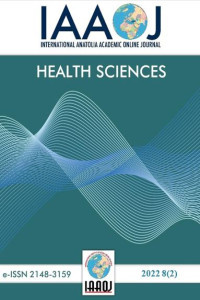KAN TRANSFÜZYONUNDA HEMŞİRELİK UYGULAMALARININ DEĞERLENDİRİLMESİ
Araştırma, kan transfüzyonunda hemşirelik uygulamalarının değerlendirilmesi amacı ile planlandı. Tanımlayıcı ve çok merkezli olarak gerçekleştirilen araştırmanın örneklemini Ekim 2014- Nisan 2015 tarihleri arasında iki Üniversite Hastanesi’nde çalışan ve kan transfüzyonu uygulayan 192 hemşireoluşturdu. Veriler araştırmacı tarafından oluşturulan demografik veri bilgi formu ve transfüzyon uygulama basamaklarını oluşturan check listler kullanılarak toplandı vePearson Ki-Kare testi ve Fisher Exact testleri ile değerlendirildi. Hemşirelerin çoğunluğu 23-25 yaş grubunda (%48.4), lisans mezunu (%72.4) olup, 2-3 yıl (%30.7) süreyle dahiliye (%29.2) ve cerrahi kliniklerinde (% 42.2) çalışmakta idi. Hemşirelerin, kan transfüzyonu öncesi kan ürünü ve kimlik doğrulamayı (%92), crossmatch yapılıp yapılmadığını kontrol ettikleri (%98), serolojik test sonuçlarını (%97) ve transfüzyon formundaki ürün bilgileri ile ürün etiketindeki bilgilerinin uyumunun kontrolünü (%97) yaptıkları gözlendi.Tüm birimlerde çalışan hemşirelerin çoğunluğunun ise kan transfüzyonundaki uygulama basamaklarını doğru olarak uyguladıkları saptandı
Anahtar Kelimeler:
kan transfüzyonu, kan, kan ürünleri, hemşire
ASSESSMENT OF NURSING PRACTICE OF BLOOD TRANSFUSION
The study was designed to evaluate the application of nurses in blood transfusion. The sample of study conducted as a multicenter and descriptive occurred 192 nurses who was employees of the two university hospitals and blood transfusion implementing between October 2014- April 2015.Data on demographic data were collected using information forms and checklists created by researchers form the transfusion practice steps and It was assessed with Pearson chisquare test and fisherexact tests. Results in 95% confidence interval, P <0.05 was considered significant. The majority of nurses in the 23-25 age group (48.4%), graduate degree is (72.4%), 2-3 years (30.7%) for a period of internal medicine (29.2%) and surgical clinics (42.2%) are employed. Nurses and the authentication blood products before performing a blood transfusion (92%), cross match control that made making (98%), control of blood products that negative serological test results (97%), transfusion in the form of product information and the control of the compliance of the information in the product label (97%) were observed to do. The majority of nurses in blood transfusion practices was found to apply the correct steps.
Keywords:
blood transfusion, blood, blood products, nurse,
- Yayın Aralığı: Yılda 3 Sayı
- Başlangıç: 2013
- Yayıncı: Abdülkadir IŞIK
Sayıdaki Diğer Makaleler
Ebru ÖNLER, Tülin Yıldız, Ezgi Rumeysa SÜZEN, Hamide AYDINYILMAZ, Özge Bengü URCANOĞLU, Önder KILIÇ, Arzu MALAK
BASI YARASINDA MAGGOT DEBRİDMAN TEDAVİSİ: OLGU SUNUMU
Seval Yağız, Sonay BALTACI GÖKTAŞ
Sevda Güzel, Roman PAVELA, Gamze KOKDIL
KAN TRANSFÜZYONUNDA HEMŞİRELİK UYGULAMALARININ DEĞERLENDİRİLMESİ
